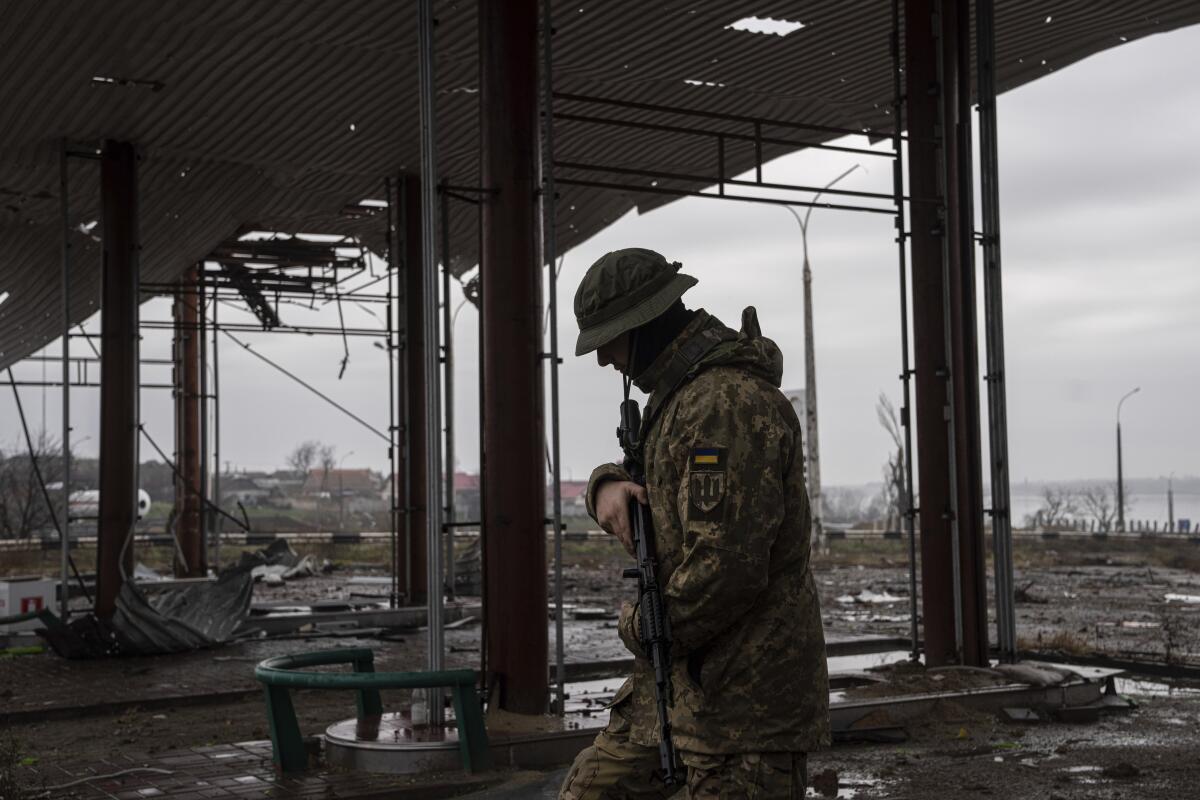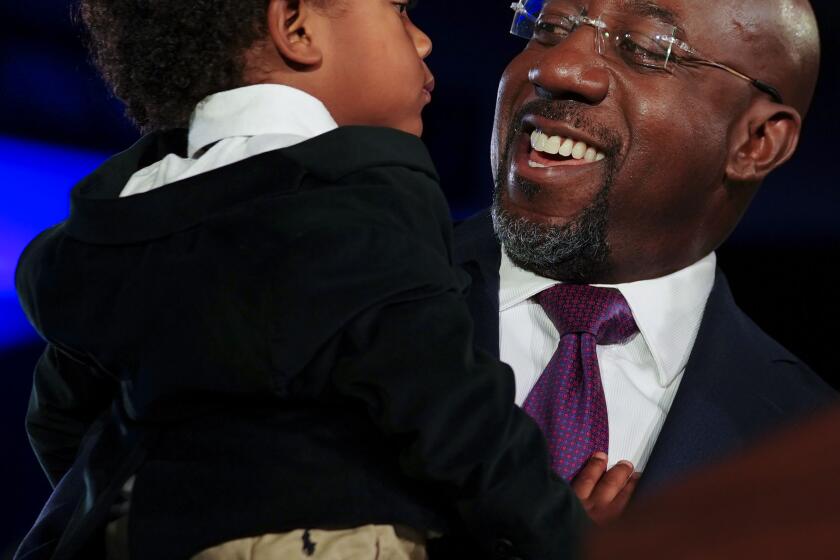U.S. policy makes Ukraine fight by rules Russia doesn’t follow

- Share via
WASHINGTON — Last week, Ukraine pulled off an audacious military feat: three drone strikes deep inside Russia, one against a target less than 150 miles from Moscow.
The drones attacked bases from which Russia has launched airstrikes against Ukraine’s cities, electricity grid and other infrastructure.
It’s not clear that they caused major damage; at least two airplanes were struck, and a fuel storage tank was set ablaze. But they revealed a surprising weakness in Russia’s air defenses.
Sen. Raphael Warnock’s reelection made clear that Georgia will remain a critical battleground, joining Arizona. The electoral math for 2024 has changed.
Equally striking was Russia’s low-key response. There were no high-decibel denunciations or threats of retaliation, perhaps out of embarrassment or a desire to avoid rattling Russian civilians.
The Biden administration’s response was curious too. Nobody congratulated the plucky Ukrainians for the mission’s success. Instead, officials quickly made clear that the United States had nothing to do with it.
“We have neither encouraged nor enabled the Ukrainians to strike inside of Russia,” Secretary of State Antony J. Blinken told reporters.
Other officials added that the United States has not supplied Ukraine with weapons that could reach as far as the drones flew.
It’s time to change that.
The administration’s dour reaction to the drone attacks was in keeping with the self-imposed limits Biden’s team has observed as it has pumped billions of dollars in weaponry and economic aid to the embattled Kyiv government: No U.S. or other NATO troops in Ukraine; no NATO aircraft in Ukrainian airspace; no NATO-supplied weapons that can strike deep inside Russia.
The goal is to avoid crossing any boundaries Russian President Vladimir Putin might consider “red lines” — actions that might provoke him to retaliate against the West.
“We’re trying to avoid World War III,” President Biden has said repeatedly.
The result has been a tacit set of rules under which Russia and the North Atlantic Treaty Organization have shown a measure of restraint toward each other. NATO has poured military supplies into Ukraine; Russia has largely spared the supply convoys from direct attack, at least in areas near Ukraine’s border with Poland and other NATO countries.
In that sense, the policy has succeeded. Last month, when two missiles fell near a Polish village, U.S. officials quickly determined that they were Ukrainian rockets that had gone astray — a crisis averted.
But the unintended result of U.S. policy has been a war in which Ukraine and Russia fight under unequal rules.
The restraint Russia has shown toward NATO contrasts sharply with the apparent lack of limits on its bombardment of Ukrainian cities: Russia has struck residential neighborhoods, hospitals and schools, as well as legitimate military targets.
By contrast, until last week, Ukraine largely avoided firing on Russian territory, except for on a handful of ammunition dumps and fuel depots close to the frontier — all military targets.
One more curiosity: Nobody’s quite sure where Putin’s red lines are.
“They have been careful not to spell out red lines that they’ve been clear they’ll enforce,” Alexander R. Vershbow, a former U.S. ambassador to Russia, told me. “They’ve gotten us to self-deter.”
Ukraine has tested the purported lines several times, with no apparent penalty. Moscow protested after Ukraine shelled military installations near Belgorod, about 25 miles inside Russian territory, but Kyiv was not deterred.
The United States has been more cautious. The administration has refused Ukraine’s repeated pleas for the Army Tactical Missile System, an advanced ground-to-ground missile with a range of almost 200 miles, for fear that Ukrainian units might fire across the border.
Providing ATACMS, as the missiles are known, would risk “heading down the road toward a Third World War,” Biden’s national security advisor, Jake Sullivan, explained in July.
But Ukraine has continued to ask for the missiles, and a growing number of critics, including members of Congress from both parties, have urged the administration to relax the prohibition.
“The administration has tended to err on the side of caution,” said Steven Pifer, a former U.S. ambassador to Ukraine who favors supplying Ukraine with ATACMS.
Pifer has proposed a sensible compromise: The United States could provide Ukraine with the long-range missiles but prohibit Kyiv from firing them into Russia.
“ATACMS would be very effective inside Ukraine; they would make it far more difficult for the Russians to conduct the war,” he said. “ATACMS would force them to pull their artillery and their ammunition way back from the front lines.”
The prohibition against firing the missiles into Russia would be self-enforcing, he added.
“The Ukrainians would know that their access [to ATACMS] would end if they violated the rule.”
Providing those long-range missiles to Ukraine, even under restrictions, would have far greater military effect than last week’s drone strikes, which one expert dismissed as “boutique attacks.”
Russia is waging a war of attrition, trying to wear down Ukraine’s armed forces, demoralize its people and discourage its allies.
“Time is an important factor here,” Pifer warned. “The West’s economic sanctions against Russia haven’t had their full effect yet.
“Here’s the key question,” he added. “Will economic sanctions erode Russia’s will to fight before the damage to Ukraine’s economy and infrastructure erodes theirs?”
Ukraine still needs all the help it can get, beginning with economic aid and antiaircraft missiles — and including those ATACMS.
More to Read
Get the L.A. Times Politics newsletter
Deeply reported insights into legislation, politics and policy from Sacramento, Washington and beyond. In your inbox three times per week.
You may occasionally receive promotional content from the Los Angeles Times.












